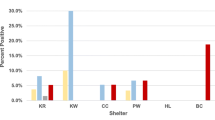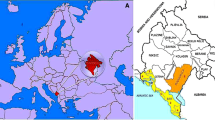Abstract
Dogs can carry and share zoonotic pathogens with humans. This problem is understudied in different parts of the world, including Jordan. This study determined the prevalence of Anaplasma phagocytophilum, Ehrlichia canis, Dirofilaria immitis, and Borrelia burgdorferi using the SNAP 4Dx Plus test and spotted fever group rickettsiae (SFGR) using enzyme immunoassay IgG test in different types of dogs (farm/breeding, police, and stray) in Jordan. The results showed a very high seroprevalence (87%) of SFGR in dogs all over Jordan. Specifically, the seroprevalence was 97.0, 90.5 and 71.2% in farm, stray, and police dogs, respectively. Overall, 9.9% of dogs were seropositive for A. phagocytophilum. Specifically, 14.9% of farm, 14.3% of stray, and 0% of police dogs were seropositive. None of the studied dogs had D. immitis, E. canis, or B. burgdorferi. It can be concluded that SFGR and A. phagocytophilum are endemic in Jordan. This study suggests that controlling stray dogs and monitoring dog breeding farms should be considered as control measures to limit the transmission of SFGR and A. phagocytophilum and to limit their public health impact in Jordan. Moreover, further follow-up studies are needed to study these pathogens in the human population in Jordan.
Similar content being viewed by others
References
Bakken JS, Dumler JS (2015) Human granulocytic anaplasmosis. Infect Dis Clin N Am 29:341–355
Barth C, Straubinger RK, Krupka I, Muller E, Sauter-Louis C, Hartmann K (2014) Comparison of different diagnostic assays for the detection of Borrelia burgdorferi-specific antibodies in dogs. Vet Clin Pathol 43:496–504
Benelli G (2018) Managing mosquitoes and ticks in a rapidly changing world—facts and trends. Saudi J Biol Sci. https://doi.org/10.1016/j.sjbs.2018.06.007
Benelli G, Duggan MF (2018) Management of arthropod vector data—social and ecological dynamics facing the One Health perspective. Acta Trop 182:80–90
Bhide M, Travnicek M, Curlik J, Stefancıková A (2004) The importance of dogs in eco-epidemiology of Lyme borreliosis: a review. Vet Med Czech 49:135–142
Cardoso L, Mendao C, Madeira de Carvalho L (2012) Prevalence of Dirofilaria immitis, Ehrlichia canis, Borrelia burgdorferi sensu lato, Anaplasma spp. and Leishmania infantum in apparently healthy and CVBD-suspect dogs in Portugal--a national serological study. Parasit Vectors 5:62. https://doi.org/10.1186/1756-3305-5-62
Chandrashekar R, Mainville CA, Beall MJ, O'Connor T, Eberts MD, Alleman AR, Gaunt SD, Breitschwerdt EB (2010) Performance of a commercially available in-clinic ELISA for the detection of antibodies against Anaplasma phagocytophilum, Ehrlichia canis, and Borrelia burgdorferi and Dirofilaria immitis antigen in dogs. Am J Vet Res 71:1443–1450
Cochez C, Ducoffre G, Vandenvelde C, Luyasu V, Heyman P (2011) Human anaplasmosis in Belgium: a 10-year seroepidemiological study. Ticks Tick-borne Dis 2:156–159
Dahlgren FS, Heitman KN, Drexler NA, Massung RF, Behravesh CB (2015) Human granulocytic anaplasmosis in the United States from 2008 to 2012: a summary of national surveillance data. Am J Trop Med Hyg 93:66–72
Dantas-Torres F, Chomel BB, Otranto D (2012) Ticks and tick-borne diseases: a One Health perspective. Trends Parasitol 28:437–446
Edouard S, Koebel C, Goehringer F, Socolovschi C, Jaulhac B, Raoult D, Brouqui P (2012) Emergence of human granulocytic anaplasmosis in France. Ticks and Tick-borne Dis 3:403–405
Farkas R, Gyurkovszky M, Lukács Z, Aladics B, Solymosi N (2014) Seroprevalence of some vector-borne infections of dogs in Hungary. Vector Borne Zoonotic Dis 14:256–260
Forshey BM, Stewart A, Morrison AC, Gálvez H, Rocha C, Astete H, Eza D, Chen HW, Chao CC, Montgomery JM, Bentzel DE, Ching WM, Kochel TJ (2010) Epidemiology of spotted fever group and typhus group rickettsial infection in the Amazon basin of Peru. Am J Trop Med Hyg 82:683–690
Goldstein RE, Eberts MD, Beall MJ, Thatcher B, Chandrashekar R, Alleman AR (2014) Performance comparison of SNAP® 4Dx® Plus and AccuPlex®4 for the detection of antibodies to Borrelia burgdorferi and Anaplasma phagocytophilum. Int J Appl Res Vet M 12:141–147
Gómez-Quintero CH, Faccini-Martínez ÁA, Botero-García CA, Lozano M, Sánchez-Lerma L, Miranda J, Mattar S, Hidalgo M (2017) Probable case of spotted fever group rickettsial infection in a new suspected endemic area, Colombia. J Infect Public Health 10:353–356
Goossens HAT, van den Bogaard AE, Nohlmans MKE (2001) Dogs as sentinels for human Lyme Borreliosis in the Netherlands. J Clin Microbiol 39:844–848
Harrus S, Waner T (2011) Diagnosis of canine monocytotropic ehrlichiosis (Ehrlichia canis): an overview. Vet J 187:292–296
Hovius KE, Rijpkema SG, Westers P, van der Zeijst BA, van Asten FJ, Houwers DJ (1999) A serological study of cohorts of young dogs, naturally exposed to Ixodes ricinus ticks, indicates seasonal reinfection by Borrelia burgdorferi sensu lato. Vet Q 21:16–20
Izzard L, Cox E, Stenos J, Waterston M, Fenwick S, Graves S (2010) Serological prevalence study of exposure of cats and dogs in Launceston, Tasmania, Australia to spotted fever group rickettsiae. Aust Vet J 88:29–31
Kohn B, Silaghi C, Galke D, Arndt G, Pfister K (2011) Infections with Anaplasma phagocytophilum in dogs in Germany. Res Vet Sci 91:71–76
Levin ML, Killmaster LF, Zemtsova GE, Ritter JM, Langham G (2014) Clinical presentation, convalescence, and relapse of rocky mountain spotted fever in dogs experimentally infected via tick bite. PLoS One 9(12):e115105. https://doi.org/10.1371/journal.pone.0115105
Liang FT, Jacobson RH, Straubinger RK, Grooters A, Philipp MT (2000) Characterization of a Borrelia burgdorferi VlsE invariable region useful in canine Lyme disease serodiagnosis by enzyme-linked immunosorbent assay. J Clin Microbiol 38:4160–4166
Lim S, Irwin PJ, Lee S, Oh M, Ahn K, Myung B, Shin S (2010) Comparison of selected canine vector-borne diseases between urban animal shelter and rural hunting dogs in Korea. Parasit Vectors 3:32. https://doi.org/10.1186/1756-3305-3-32
Little SE (2010) Ehrlichiosis and anaplasmosis in dogs and cats. Veterinary Clinics of North America: Vet Clin North Am Small Anim Pract 40:1121–1140
Littman MP, Gerber B, Goldstein RE, Labato MA, Lappin MR, Moore GE (2018) ACVIM consensus update on Lyme borreliosis in dogs and cats. J Vet Intern Med 32:887–903
McCall JW, Genchi C, Kramer LH, Guerrero J, Venco L (2008) Heartworm disease in animals and humans. Adv Parasitol 66:193–285
McMahan CS, Wang D, Beall MJ, Bowman DD, Little SE, Pithu PO, Sharp JL, Stich RW, Yabsley MJ, Lund RB (2016) Factors associated with Anaplasma spp seroprevalence among dogs in the United States. Parasit Vectors 9:9. https://doi.org/10.1186/s13071-016-1431-7
McQuiston JH, Guerra MA, Watts MR, Lawaczeck E, Levy C, Nicholson WL, Adjemian J, Swerdlow DL (2011) Evidence of exposure to spotted fever group rickettsiae among Arizona dogs outside a previously documented outbreak area. Zoonoses Public Health 58:85–92
Mircean V, Dumitrache MO, Györke A, Pantchev N, Jodies R, Mihalca AD, Cozma V (2012) Seroprevalence and geographic distribution of Dirofilaria immitis and tick-borne infections (Anaplasma phagocytophilum, Borrelia burgdorferi sensu lato, and Ehrlichia canis) in dogs from Romania. Vector Borne Zoonotic Dis 12:595–604
Miro G, Montoya A, Roura X, Galvez R, Sainz A (2013) Seropositivity rates for agents of canine vector-borne diseases in Spain: a multicentre study. Parasit Vectors 6:117. https://doi.org/10.1186/1756-3305-6-117
Mrljak V, Kuleš J, Mihaljević Ž, Torti M, Gotić J, Crnogaj M, Živičnjak T, Mayer I, Šmit I, Bhide M, Barić Rafaj R (2017) Prevalence and geographic distribution of vector-borne pathogens in apparently healthy dogs in Croatia. Vector Borne Zoonotic Dis 17:398–408
Mylonakis ME, Theodorou KN (2017) Canine monocytic ehrlichiosis: an update on diagnosis and treatment. Acta Veterinaria 67:299–317
Pantchev N (2010) C-reactive protein as a marker in canine granulocytic anaplasmosis. Vet Rec 166:632. https://doi.org/10.1136/vr.c2546
Pantchev N, Schaper R, Limousin S, Norden N, Weise M, Lorentzen L (2009) Occurrence of Dirofilaria immitis and tick-borne infections caused by Anaplasma phagocytophilum, Borrelia burgdorferi sensu lato and Ehrlichia canis in domestic dogs in France: results of a countrywide serologic survey. Parasitol Res 105(Suppl 1):S101–S114
Perez Vera C, Kapiainen S, Junnikkala S, Aaltonen K, Spillmann T, Vapalahti O (2014) Survey of selected tick-borne diseases in dogs in Finland. Parasit Vectors 7:285. https://doi.org/10.1186/1756-3305-7-285
Simon F, Siles-Lucas M, Morchón R, González-Miguel J, Mellado I, Carretón E, Montoya-Alonso JA (2012) Human and animal dirofilariasis: the emergence of a zoonotic mosaic. Clin Microbiol Rev 25:507–544
Steere AC, Strle F, Wormser GP, Hu LT, Branda JA, Hovius JW, Li X, Mead PS (2016) Lyme borreliosis. Nat Rev Dis Primers 2:16090. https://doi.org/10.1038/nrdp.2016.90
Tesouro MA, Bacellar F, Sainz A, Filipe A (1998) Persistence of antibodies to Rickettsia conorii in dogs. Ann N Y Acad Sci 849:441–443
Thomas RJ, Dumler JS, Carlyon JA (2009) Current management of human granulocytic anaplasmosis, human monocytic ehrlichiosis and Ehrlichia ewingii ehrlichiosis. Expert Rev Anti-Infect Ther 7:709–722
Wachter M, Pfeffer M, Schulz N, Balling A, Chirek A, Bach JP, Moritz A, Kohn B, Pachnicke S, Silaghi C (2015) Seroprevalence of spotted fever group Rickettsiae in dogs in Germany. Vector Borne Zoonotic Dis 15:191–194
Wood H, Artsob H (2012) Spotted fever group rickettsiae: a brief review and a Canadian perspective. Zoonoses Public Health 59(Suppl 2):65–79
Acknowledgments
This study was supported by the Deanship of Research at the Jordan University of Science and Technology (Project 100/2015). The authors acknowledge Alaa E. Bani Salman and Amany K. Rashaideh for their support in implementing this study.
Author information
Authors and Affiliations
Corresponding author
Ethics declarations
Conflict of interest
The authors declare that they have no competing interests.
Ethical approval
This study was approved by the Institutional Animal Care and Use Committee. All dog owners were briefed regarding the study objectives. It was emphasized to the dog owners/guardians that this study is for research purposes. It was also emphasized that their decision to allow sampling from their animals is completely voluntarily and their decision would not affect needed veterinary care of their animals. To achieve proper collection and to gain access to dog farms, private veterinarians assisted the researchers in blood collection and interviews.
Rights and permissions
About this article
Cite this article
Obaidat, M.M., Alshehabat, M.A. Zoonotic Anaplasma phagocytophilum, Ehrlichia canis, Dirofilaria immitis, Borrelia burgdorferi, and spotted fever group rickettsiae (SFGR) in different types of dogs. Parasitol Res 117, 3407–3412 (2018). https://doi.org/10.1007/s00436-018-6033-1
Received:
Accepted:
Published:
Issue Date:
DOI: https://doi.org/10.1007/s00436-018-6033-1




